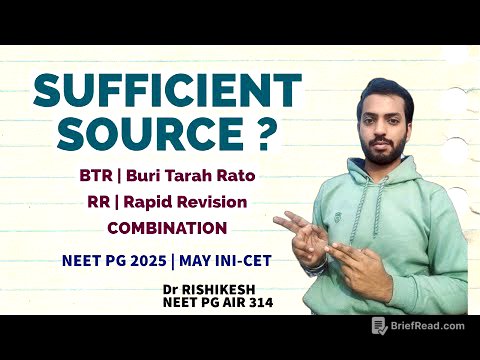TLDR;
This video by Dr. Sweta Adatia talks about vagal mastery, highlighting its importance for stress reduction, peak performance, and overall health. The vagus nerve, the longest in the body, plays a crucial role in balancing the sympathetic (fight, flight, freeze) and parasympathetic (rest and digest) nervous systems. The video outlines ten practical steps to enhance vagal function, including cold showers, fasting, eye exercises, massage, grounding, specific breathing techniques, humming, and stimulating brain buttons. By incorporating these techniques into daily life, one can improve heart rate variability, reduce stress, and promote overall well-being.
- Vagal mastery is key to stress-free living and overall health.
- The vagus nerve balances the sympathetic and parasympathetic nervous systems.
- Ten practical steps can enhance vagal function daily.
Intro [0:00]
Dr. Sweta Adatia introduces the topic of vagal mastery, emphasising its importance in achieving a stress-free life, peak performance, and overall balance in the body's physiology. She expresses concern that despite medical advancements, health is deteriorating because people are not consciously taking care of themselves using simple, accessible methods. The video aims to highlight the significance of understanding and mastering the vagus nerve to eliminate diseases and improve well-being.
What is Vagus Mastery? [1:18]
The vagus nerve, the longest nerve in the body, extends from the brain to the toes, constantly sensing and relaying information about the body's state back to the brain. It is crucial for maintaining balance, especially between the sympathetic (fight, flight, freeze) and parasympathetic (rest and digest) nervous systems. Vagal mastery refers to enhancing the parasympathetic tone, which is essential for rest, digestion, and overall physiological balance.
10 Steps for a Functional Vagus Mastery [2:18]
Dr. Sweta outlines ten steps to improve vagal nerve function. These include taking cold showers (or alternating between warm and cold), intermittent fasting, rolling the eyeballs up and down, gently massaging the sides of the neck where the vagus nerve passes, walking barefoot to promote grounding, practicing breathing exercises with a 1:2 inhale-to-exhale ratio, and humming. These techniques are simple and can be easily incorporated into daily routines.
How Does an Ice Bath Help Activate the Vagus Nerve? [4:00]
Fasting is highlighted as a significant vagal kicker, promoting mental alertness and improving metabolism. Dr. Sweta shares that she fasts for 14-16 hours and incorporates longer fasts weekly or monthly. She also references the traditional practice of fasting on specific days, like Ekadashi. The cold water exposure after sauna sessions helps shift the body from the sympathetic to the parasympathetic state, activating the vagus nerve.
How Does Walking Barefoot in Nature Activate the Vagus Nerve? [5:20]
Walking barefoot, also known as grounding, helps eliminate negative ions and promotes alpha frequency in the brain, thereby stimulating the vagus nerve. Breathing exercises with a longer exhale than inhale (1:2 ratio) are effective in activating the vagus nerve. Any pranayam that follows this ratio can be beneficial.
What is a Humming Bee Technique? [6:03]
Humming, particularly the Bhramari pranayam (bee breath), not only generates gamma waves, which optimize brain function, but also activates the vagus nerve. Dr. Sweta recommends visiting her Bhramari video for detailed instructions. Singing karaoke or humming along to music can also stimulate the vagus nerve.
What Are the Brain Buttons? [7:20]
Stimulating the brain buttons, located about two finger breaths from the sternum, through gentle massage or tapping can activate the vagus nerve and promote calmness. Dr. Sweta shares her technique of using brain buttons combined with a "power Bhramari" (humming with eyes and ears closed) to combat tiredness during travel.
What is Heart Rate Variability? [8:30]
Heart rate variability (HRV) reflects how well the heart adapts to changes. An improved HRV and a decreased pulse rate indicate effective vagal mastery. A fixed heart rate suggests a lack of adaptability and potential health risks.
How to Balance the Sympathetic & Parasympathetic Nervous Systems? [8:50]
The goal of these techniques is to balance the sympathetic and parasympathetic nervous systems. Dr. Sweta encourages viewers to incorporate these vagal mastery tips into their daily lives and share their experiences in the comments. She also mentions an upcoming workshop featuring new gadgets like neurosim, as well as ancient techniques to strengthen the vagus nerve.









